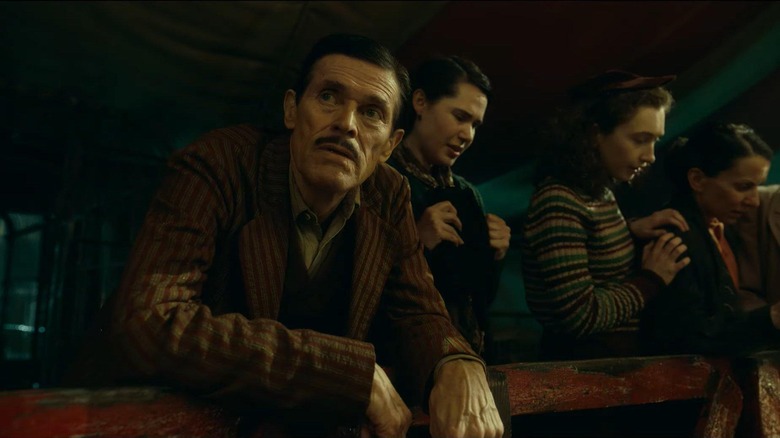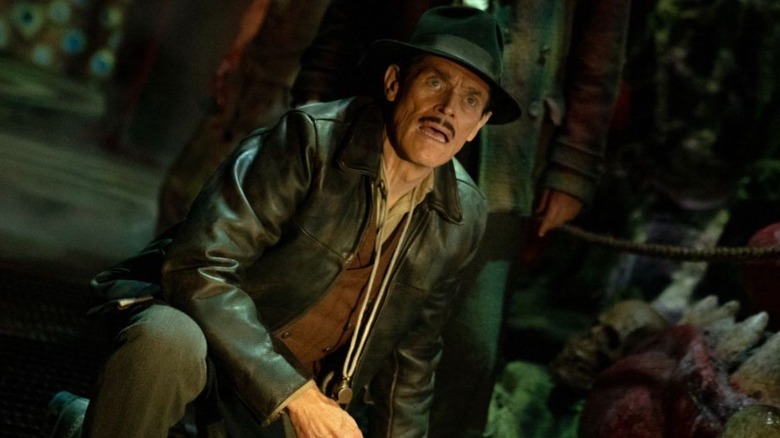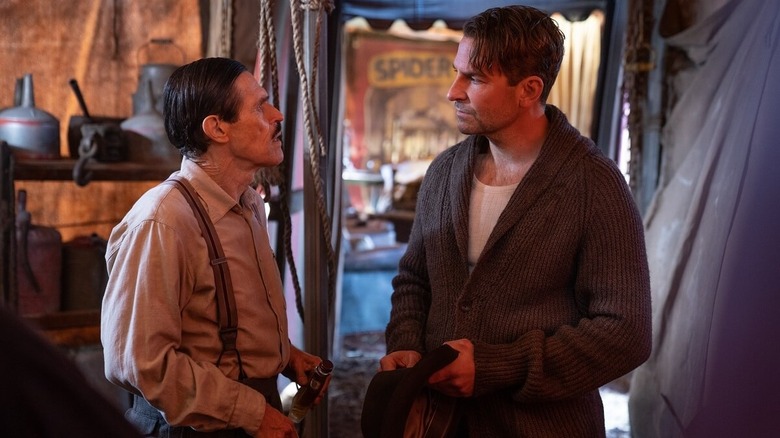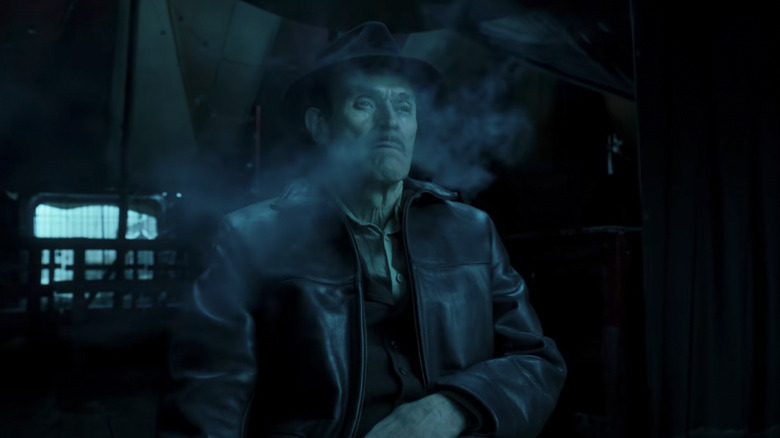Why Nightmare Alley Star Willem Dafoe Hates Day One Of Shooting [Interview]
The masks people wear is one of the themes explored in Guillermo del Toro's "Nightmare Alley," but if there's one character in the lavish film not disguising their true nature, it's Clem (Willem Dafoe). He's the man in charge of the carnival, and he's responsible, as he describes in one bone-chilling sequence with no blood or graphic horror, for breaking in a new "geek," a down-on-his-luck alcoholic who's given a few drops of liquor in exchange for eating a live chicken in front of a repulsed crowd at the carnival.
"Pure business" is how actor Willem Dafoe describes his character – a businessman, not a showman. "Very objective," he told us in a recent interview, "and his main priority is his world, the people, keeping that together, taking care of his wife, taking care of his carnival family." Clem has no illusions about who he is, what he does, or what he offers the world. With Dafoe's genial charm — especially when he warns Stan (Bradley Cooper) with a sunny smile — Clem is a frightening character totally willing to break a man for a buck. Dafoe told us about filming that startling sequence in which Clem lays out his methods and why first days are not his favorite days on set.
"They can lose their humanity if you know how to play them"
Kim Morgan and Guillermo del Toro's dialogue is really fun. What was enjoyable about delivering it?
Well, the nice thing was there was a very strong script when I signed on to do it, and then in the process of making it, we kept on tweaking the language, because both Kim and Guillermo became much more interested in finding the period vernacular and finding slang and expressions that you may not exactly understand, but had a texture of that world, almost a coded kind of language. There's not a lot, but there's enough that it was fun. It helps you enter the world, because it's so specific. It doesn't remind you of anything. You're making a world with that new language.
Any slang or expressions you particularly enjoyed?
No, I was trying — I anticipated this, because it's interesting. I was trying to think today, and none comes to mind right away. I'm sorry.
That's okay.
Yeah, but apparently it's distinct enough that you did notice there was some slang, and very specific carny talk.
You probably get the most detailed carny talk when Clem explains how to make a geek, and just how casual he is in that scene, it makes it more horrifying.
That was the first thing I shot. I'd just arrived, and it's a dialogue-heavy scene, and it was baptism by fire, you know? I just jumped in. But it's basically a story, and when you have a long text like that, you get pretty familiar with it, and you find a rhythm and you find a music, and that's your place that you start. Then of course, once you get there and you're in that place, it gets textured by the experience.
Particularly when you do a text-heavy scene, it's got to be considered much before, because not only just to memorize the text, but to have a sense of what you're trying to convey. And this is a story. It's got a logic to it, it's a way of being, it's an expression of his objectivity, and tells a lot about his worldview and his philosophy of life, in the sense of his special relationship to the character of people and the character of their desires and their addictions, and how they can be reduced very easily. You know, they can lose their humanity if you know how to play them.
How do you usually feel on day one of shooting?
I hate day one shooting, because you're seldom relaxed. But it was fine, it was fine, and Bradley's a good partner. And also, it's quite a simple scene in the respect that we're seated down at a table, and other than the business of eating, it's a pretty direct scene. You're talking to the guy, you're telling him the story. So it wasn't a bad way to start, but first days are always hard, because you're folding into the world. Also, if people have been shooting before, they've got their rhythm and you have to kind of hop on board. You got to suss out what they're doing and join them. It's hopping on a moving train, you know? It's difficult that way.
"You're dancing with the camera"
How technical is del Toro when it comes to performance, whether in a scene such as "how to break a geek" or the walk-and-talks through the carnival?
You know, we shot all kinds of things, we invented a lot of things. Some of it doesn't necessarily end up in the movie, but you get the texture, you get the feeling of the world. It was wonderful that the carnival is so beautifully designed, and they basically built a carnival [for real]. And it was quite cold, but you'd arrive there at night sometimes, and the lights would start coming on, it was like a world starting to be activated. When you entered it, it was beautiful, because it almost really functioned. And then you add extras to it, it almost feels like a carnival. You approach it, you see the lights on. It's a little bit like entering a movie set, so it's like, 'Here we go.' And then that world finds its own rhythm, and you fold yourself into that rhythm, and you have an experience.
So that's a beautiful thing, when you can make such a complete world, because the reality doesn't exist only in the frame. It goes beyond that, because there's lots going on, and you have the flexibility to move about that carnival set, because so much of it functions, you know? The fun house really functions, everything works. It was cool for that.
On days at the carnival with all those extras and other elements, how closely did you work with [cinematographer] Dan Laustsen?
The camera moves a lot. A lot of stuff pushes, a lot of stuff moves around, so you're dancing with the camera. A lot of that is worked out with, of course, Guillermo and Dan and their collaborators, so you just got to be hip to it. You got to know what the rhythm of that stuff is, and it's fun. I always like that, because that gives you a structure. That gives you a structure and a rhythm, because as I say, the camera's moving around a lot, and we're using Technocranes, a lot pushing in on stuff and then panning off. It's fun. I like it when the camera moves. Sometimes we're with a more formal framing too, but for scenes like this where there's lots of activity, it's nice. It's nice.
"Sometimes a little ignorance isn't a bad thing"
When you're in a remake or an adaptation, or both in the case of "Nightmare Alley," how much do you go back to the original source material?
It's funny. Case by case, there's no rule. Usually, you look at the screenplay first, and you talk to the director, you see what he or she is interested in, and you just do whatever research you need to do, like you have the authority to pretend or enter that, or to make something, to enter that world. So it really depends, because sometimes, if it's a freer adaptation, if you have too much loyalty or allegiance to the original material, you can be kind of torn, and it can kind of stress you out. You have to be free.
As far as the original film, I had seen the original film, so I did go back to it. But it's so different, and our perspective is so different. You know, it had a different purpose. It sat in a different America than we know right now. This is so much informed by what's happening now, as opposed to 1947, the war had just happened. We're so far away from World War II, we've got other things going on ... you watch it, but it doesn't help you that much. I didn't feel a need to study it.
For example, my character almost doesn't exist in the original. So you can appreciate what the impulse is to tell that story, that helps. But as far as the actual details, it can be a distraction. As I say, in the original my character barely existed, but let's say it's a fantastic performance and you love it. Then you got to come up against that, you know? So sometimes a little ignorance isn't a bad thing, and you have to make your own way.
"Nightmare Alley" is in theaters now.



